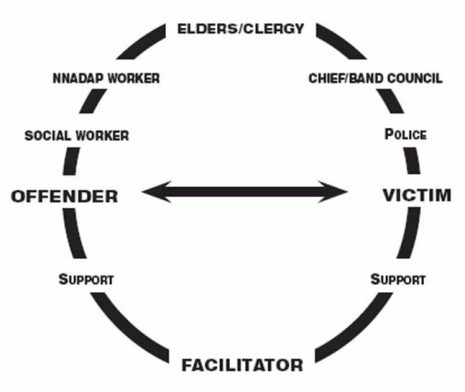Restorative Justice
MAA-MII-NAH-CHI-KE-WIN
In 1990, Nishnawbe-Aski Legal Services Corporation (NALSC) received direction from the Chiefs of Treaty No. 9 to create and promote alternative and community-based justice systems for its members. The Restorative Justice Program was created in 1996, and it is this mandate received from the Chiefs that NALSC delivers by providing Restorative Justice to the 49 First Nation communities in the Nishnawbe Aski Nation territory.
Restorative Justice, “Maa-Mii-Nah-Chi-Ke-Win”
Restorative Justice is defined as an Alternative form of Justice that focuses on addressing the harm caused by crime while holding the offender responsible for their actions. A Referral comes in, a healing circle is facilitated. This circle provides an opportunity for the parties directly affected by the crime – victims, offenders and community members – to identify and address their needs.
The principles of Restorative Justice are based on respect, compassion and inclusivity. Restorative Justice encourages meaningful engagement and accountability. It provides an opportunity for healing, reparation and reintegration.
The process starts with a traditional circle, led by a Restorative Justice Facilitator. The Goal of the circle is to reach an agreement. Within this agreement, the offender agrees to take a course of action to repair harms caused to the victim. It is up to the Offender to put in the effort and dedication needed to uphold the agreement. If the offender is successful in meeting the conditions set by the circle, then the matter is closed. If the agreement is not completed, the matter is referred back to the court to proceed regularly.
Examples of Conditions, from the Agreements made in a circle:
- Volunteering in the community
- Assisting Elders
- Apologies
- Restitution
- Written or verbal apology
- Attending Presentations
- Attendance at school
- Testimonies, sharing of stories to provide Teaching
- Attending a treatment program/ self-help program
Referrals for Restorative Justice come from the Crown Attorney after an individual has been screened, approved for diversion in Criminal Matters. It is also used in neighborhood disturbances, workplace disputes and harassment. In schools, Restorative Justice can assist in schools with attendance, bullying, truancy and harassment.
Examples of Referred charges:
- Theft
- Assault
- Break and Enter
- Breaches
- Bullying
- Mischief
- Repetitive Warnings
This program gives all involved an opportunity to have a voice, to heal, and to grow within themselves and their communities. We want people to access further resources from this process as well as develop self-determination for positive decision making. Through motivation and understanding, Restorative Justice works towards changing the mindset of offenders to live more positively and recognize their strengths as individuals. Lastly, we also aim to replace ineffective, non-traditional and culturally unsuitable justice systems with more culturally appropriate community based healing methods.
For inquiries and referrals email
rjreferral@nanlegal.on.ca
Referral Forms
WHO CAN REFER
- Court & Crown Attorneys
- Police Officers
- Probation Officers
- Chief and Council
- Principals & Teachers
- Community Resource Workers
- Parents & Individuals
- Neighborhood Watch
What to Consider
- Has someone been harmed?
- Is there a need to repair the harm?
- Has the offender admitted responsibility?
- Could this cause further harm?
- Does the victim want this process?
Participation by all parties (victim, offender, etc.) must be voluntary.

Restorative Justice Circle "MAA-MII-CHI-KE-WIN"
Circle Participants
- Victim and their Supports
- Offender and their Supports
- Key persons involved in helping the offender and victim: Youth Workers, Social Workers, Teachers, Counselors, etc.
- Elders & Leadership